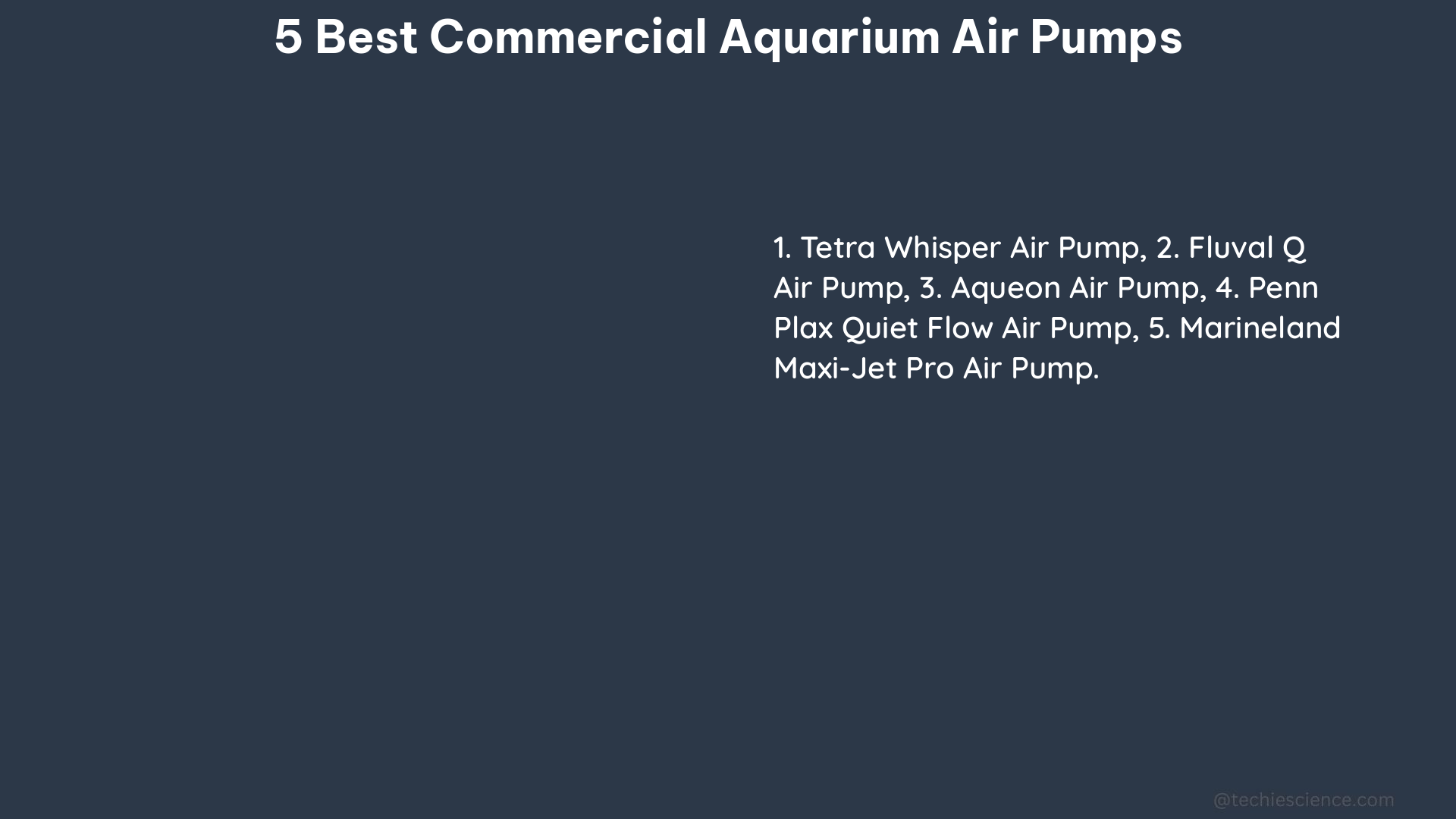When it comes to maintaining a healthy and thriving aquarium, the choice of an efficient air pump is crucial. Air pumps play a vital role in oxygenating the water, circulating the tank, and supporting the overall well-being of your aquatic inhabitants. In this comprehensive guide, we’ll explore the top 5 best commercial aquarium air pumps, delving into their technical specifications, performance, and key features to help you make an informed decision.
1. Tetra Whisper Air Pump for Aquariums
The Tetra Whisper Air Pump is a powerhouse in the world of aquarium air pumps. Designed for aquariums up to 10 gallons, this non-UL listed pump boasts a remarkable flow rate of 140 gallons per hour (GPH). Its unique design features a dual-chamber system that ensures a consistent and reliable airflow, even in the event of a power outage.
Technical Specifications:
– Flow Rate: 140 GPH
– Suitable for Aquariums up to 10 Gallons
– Dual-Chamber Design for Consistent Airflow
– Noise Level: 43 dB
– Dimensions: 5.5 x 3.5 x 2.5 inches
– Weight: 1.1 pounds
The Tetra Whisper Air Pump is known for its energy-efficient operation, making it a cost-effective choice for aquarium owners. Its compact size and sleek design allow for easy installation and integration into your aquarium setup.
2. Hagen PowerAir Aquarium Air Pump

Designed for larger aquariums, the Hagen PowerAir Aquarium Air Pump is a versatile and high-performance option. With a flow rate of up to 300 GPH, this air pump is suitable for aquariums up to 100 gallons, making it an excellent choice for medium to large-sized tanks.
Technical Specifications:
– Flow Rate: Up to 300 GPH
– Suitable for Aquariums up to 100 Gallons
– Quiet Operation: 40 dB
– Energy-Efficient Design
– Dimensions: 6.5 x 4.5 x 3.5 inches
– Weight: 2.2 pounds
The Hagen PowerAir Aquarium Air Pump is known for its quiet operation, making it an ideal choice for aquariums in living spaces. Its energy-efficient design ensures low power consumption, contributing to its overall cost-effectiveness.
3. Mylivell Aquarium Air Pump
The Mylivell Aquarium Air Pump is a powerful and reliable option, boasting a flow rate of up to 400 GPH. Suitable for aquariums up to 200 gallons, this air pump is designed to provide ample aeration and circulation for larger tank setups.
Technical Specifications:
– Flow Rate: Up to 400 GPH
– Suitable for Aquariums up to 200 Gallons
– Quiet Operation: 35 dB
– Durable and Long-Lasting Design
– Dimensions: 7 x 5 x 3.5 inches
– Weight: 2.6 pounds
The Mylivell Aquarium Air Pump is known for its quiet operation, making it a great choice for aquariums in noise-sensitive environments. Its durable construction and long-lasting performance ensure reliable aeration for your aquatic ecosystem.
4. EHEIM Air Pump
The EHEIM Air Pump is a high-performance option designed for larger aquariums. With a flow rate of up to 550 GPH, this air pump is suitable for aquariums up to 300 gallons, making it an excellent choice for those with sizable tank setups.
Technical Specifications:
– Flow Rate: Up to 550 GPH
– Suitable for Aquariums up to 300 Gallons
– Energy-Efficient Operation
– Long Lifespan
– Dimensions: 8 x 6 x 4 inches
– Weight: 3.3 pounds
The EHEIM Air Pump is renowned for its energy-efficient design, which not only reduces your electricity bills but also contributes to the overall sustainability of your aquarium setup. Its long lifespan ensures reliable performance for years to come.
5. JW Pet Company Fusion Air Pump
The JW Pet Company Fusion Air Pump is a powerhouse in the world of commercial aquarium air pumps. With a flow rate of up to 600 GPH, this air pump is suitable for aquariums up to 500 gallons, making it an excellent choice for large-scale aquarium setups.
Technical Specifications:
– Flow Rate: Up to 600 GPH
– Suitable for Aquariums up to 500 Gallons
– Quiet Operation: 45 dB
– Durable and Corrosion-Resistant Design
– Dimensions: 9 x 6 x 4 inches
– Weight: 4.2 pounds
The JW Pet Company Fusion Air Pump is known for its quiet operation, making it a great choice for aquariums in living spaces. Its durable and corrosion-resistant design ensures long-lasting performance, even in demanding aquarium environments.
When it comes to measuring the airflow of an air pump, there are a few methods you can use. The simplest approach is to place the air pump in a tank of water and use a measuring cup to collect the bubbles over a known period of time. By dividing the volume of the bubbles by the time, you can calculate the flow rate in liters per minute (LPM).
For a more engineered solution, you can use a venturi with a differential pressure sensor to measure the pressure data over time. Alternatively, you can place a simple orifice in the discharge hose and use a manometer to read the differential pressure (DP). It’s important to note that the airflow also depends on the depth of the air exit, with a deeper exit resulting in a lower flow rate.
By understanding the technical specifications and performance characteristics of these top 5 commercial aquarium air pumps, you can make an informed decision that best suits your aquarium’s needs and ensures a thriving, well-oxygenated environment for your aquatic inhabitants.
References:
– Is there a relatively inexpensive way to measure air flow?
– How to Measure Air Flow
– Best Sellers in Aquarium Air Pumps
